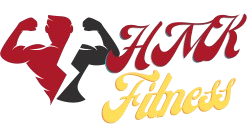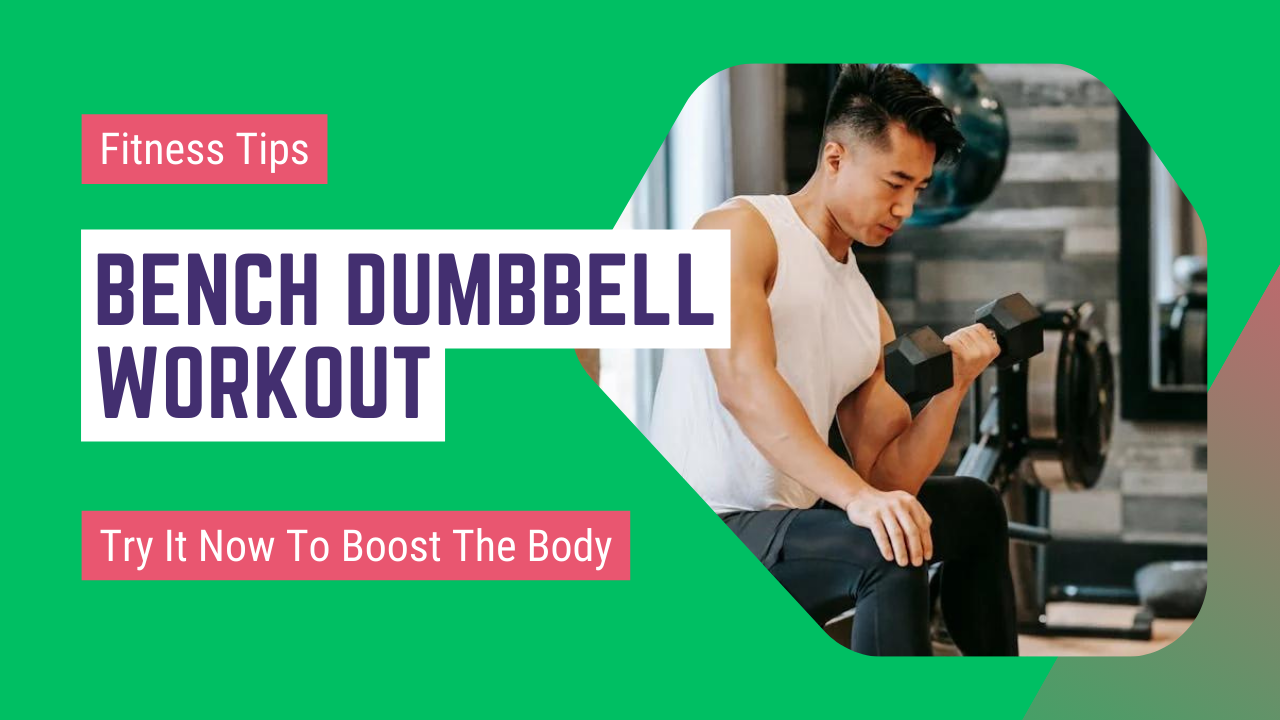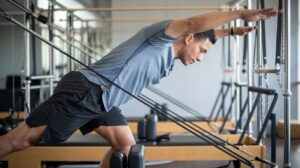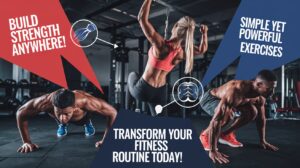Table of Contents
ToggleIntroduction:
In this article, you will learn about bench dumbbell workouts. Strength training with dumbbells is the foundation of a healthy body and mind, providing an array of exercises to build muscles and increase overall strength. These include the bench dumbbell workout routine, which effectively targets various muscle groups while being flexible enough for beginners or seasoned enthusiasts. These exercises will make the difference if you want to tone your upper body, gain strength, or simply get something different into your exercise routine.
The purpose of this guide is to provide an inclusive bench dumbbell exercise program that can be used effectively by all fitness levels. This means it can be done at home with little equipment as well as at a gym with limited machines. Now, let’s get into the basics of bench dumbbell workouts, their benefits, and how to integrate them into one’s fitness journey.
This introduction serves as an overview highlighting how versatile bench dumbbell workouts are while enticing readers to learn more about the routines and exercises described in the blog post. Just tell me if any changes need to be made or if we can proceed with the next part!
Equipment Required:
Before starting your bench dumbbell workout routine, you should have all the equipment nearby. Here’s what you need.
Bench: A good quality and firm bench is vital when performing different workouts safely and steadily; it would be better if it could be adjusted so that you may change your incline during different workouts.
Dumbbells: The weights should match your current strength level and abilities; you might choose fixed-weight ones or an adjustable set of dumbbells according to your preferences.
Optional:
Adjustable Bench: It allows changing the angle of the bench for such movements as incline or decline presses.
Resistance Bands: They add resistance in some movements, helping stretch and warm up before workouts.
These tools ensure that various exercises are executed properly, developing specific muscles while progressing along one’s fitness path. We’re moving on to the warm-up phase before starting the workout routine.
Warm-up Exercises:
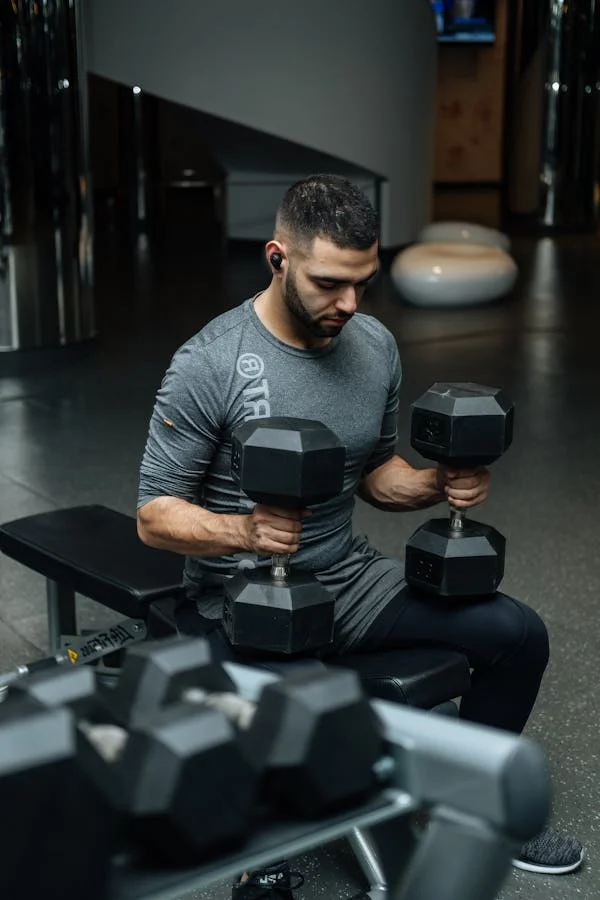
Before beginning your bench dumbbell workout routine, it is important to warm up your muscles and prepare your body for exercise. A good warm-up increases muscle circulation, improving flexibility and reducing the chance of injury. Here are some examples of simple yet efficient warm-ups.
Arm Circles:
Stand erect with arms outstretched sideways.
Begin making small circles with your arms, gradually increasing circle sizes.
Repeat this in both directions for around 30 seconds.
Shoulder Rolls: Keep your legs shoulder-width apart as you stand straight up. Forwardly rotate your shoulders in a circular motion for 15-20 seconds before reversing direction.
Light Jogging or Jumping Jacks: Do about two or three minutes of jogging in place or perform jumping jack exercises to raise your heart rate and warm up your whole body within 30-60 seconds.
These loosening exercises relax tense muscles, increase joint mobility, and make you mentally ready for the following exercises you will perform. This brief warming up will help improve performance while protecting from strains and/or muscle pulls while doing bench dumbbell workouts later.
Now that your body is warmed up and ready, review the basic bench dumbbell exercises effectively to build strength and muscle.
Basic Bench Dumbbell Exercises:
These foundational exercises in your workout regimen target the main muscle groups in your upper body. They are great for beginners and provide a strong starting point for building strength and muscles. Let’s look at three essential exercises.
Flat Bench Press:
The flat bench press is an age-old exercise mostly focused on the pectorals (chest muscles), anterior deltoids (shoulders), and triceps. This is how it should be done:
Setup: Lie flat on a bench with your feet firmly planted. Hold one dumbbell in each hand, with your palms facing away from you, elbows bent at 90 degrees.


Execution: Push them up toward the ceiling until both arms are straight out but not locked. Lower them back down under control, which makes one repetition.
Incline Bench Press:
The incline bench press targets the upper chest and front shoulder areas to get a more complete look at the chest area. Here’s how to do it:
Setup: Adjust the bench to a 30-45-degree incline. Then lie back on it, holding dumbbells in hands while ensuring they face forward.
Execution: Move these up smoothly until both arms are fully extended. Afterward, let them come down slowly again for one full repetition.
Decline Bench Press:
This decline movement focuses more on the lower chest part and helps improve the bottom chest muscles and develop the entire chest area within this context. Follow these steps below if you want to achieve this desired result:
Setup: While lying on the bench at around a 30-degree angle towards the floor, if possible, place feet securely under foot pads; otherwise, hold dumbbells against your chest
Execution: Using an upward motion,, lift them towards the the ceiling until both arms become straightened. Lower them down again with control and repeat.
Intermediate Bench Dumbbell Exercises:
After mastering the basic bench dumbbell exercises, it is time to move on to intermediate exercises that challenge the muscles even more and increase overall strength and stability. These exercises include advanced versions of the foundational movements and target specific muscle groups with greater intensity. Let’s take a look at three good intermediate exercises:
Bench Dumbbell Rows:
Bench dumbbell rows are excellent for your back muscles, especially latissimus dorsi and rhomboids. Here’s how you do them:
Setup: With one knee and hand on a flat bench, with body parallel to the ground, hold a dumbbell in the other hand with palm facing inward downwards.
Execution: Pull one end of the weight towards the hip while keeping the elbow close to the body. Stop for an instant at the top, then lower the weight backwards, slowly repeating this process only for the desired number of reps before moving to the other side.
Bench Dumbbell Flyes:
Pectorals are targeted through these flies specifically to isolate them, fostering growth and definition of chest muscles. This is how it could be done:
Setup: While lying flatly on a bench, each hand should grasp one dumbbell extended straight up above chest level so that the palms face each other.
Bench dumbbell pullovers mainly target the muscles of the chest, back, and triceps, which are important for stretching and contracting properly. Here’s how it is done:
Set up: Lie face down on a bench so that only your upper back and shoulders touch it. Pick up a dumbbell with both hands, holding it directly above your chest in an extended arm position.
Execution: Lowering the dumbbell towards the floor in a slow controlled manner while feeling a stretch in your chest and lats. Raise the dumbbell back up over your chest activating both your chest and back muscles. Repeat this move until you achieve the number of repetitions you desire.
These intermediate exercises are designed to add variety and challenge to any bench dumbbell workout routine, thus improving muscle strength, definition, and overall fitness. Focus on maintaining proper form and gradually increasing the weight as you become stronger.
Advanced Exercises for Dumbbells on the Bench:
Advanced bench dumbbell exercises are the next phase for those who want more challenges and achieve great strength and muscle building. The effectiveness of these exercises depends on how well you are able to maintain form and control. Let’s look at three advanced exercises.
Single-Arm Bench Press:
This single-arm bench press improves core stability and unilateral strength, which makes it a difficult variation from the standard bench press. How can you do it?
Set up: Lie flat on a bench with one hand holding a dumbbell while the other rests on your tummy or keeps hold of the bench for stability.
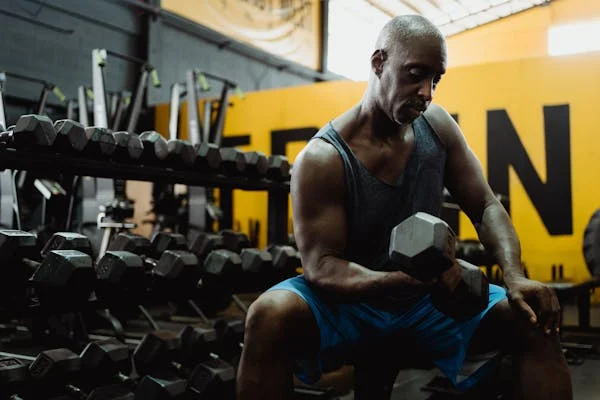

Execution: Push upward the dumbbell until your arm is fully extended. Bring it down slowly maintaining balance and stability throughout the motion. Do as many repetitions as desired, then change sides.
Bench Dumbbell Skull Crushers:
The triceps are targeted in this exercise which helps develop strong, beefy arms through heavy strength training in that area. How can you do them?
Also, read about Home workout Hacks.
Set up: Lie flat on a bench with each hand clutching one dumbbell straight up your chest.
Execution: Bend your elbows, lowering both dumbbells towards your forehead while keeping your upper arms stationary. Extend your elbows back, returning them to the start position, focusing on squeezing out the triceps on top. Repeat as many reps as required.
Bench Dumbbell Step-Ups:
Bench dumbbell step-ups enhance leg power, coordination, and balance, among others, because they are lower-body dynamic exercises. So how does it work?
Setup: Hold two dumbbells by their sides facing the bench.
Execution: Step up with one foot onto the bench, pushing through your heel. Now, step down using that same foot, repeating it by crossing over with another foot immediately after this stage without pause for breath, alternately focusing on the form only during all steps taken at a constant pace.
These advanced workouts train multiple muscle groups and promote full body strength and muscle development. You should begin with lighter weights to get the technique done correctly first before you start increasing load as your confidence and strength build up.
Sample Bench Dumbbell Workout Routine:
This sample workout routine uses various bench dumbbell exercises to target different muscles and promote overall strength and muscle development. Modify the resistance to match your fitness level and work on maintaining good form and control during each exercise.
Warm-up: Start off with warm-up movements described above so that your muscles can be ready for the whole activity.
- Flat Bench Press
Three sets of 10-12 repetitions
- Incline Bench Press
Three sets of 10-12 repetitions
- Bench Dumbbell Rows
Three sets of 10-12 repetitions per arm
- Bench Dumbbell Flyes
Three sets of 12-15 repetitions
- Single-Arm Bench Press
Three sets of 8-10 repetitions per arm
- Bench Dumbbell Skull Crushers
Three sets of 10-12 repetitions
- Bench Dumbbell Pullovers
Three sets of 12-15 repetitions
- Bench Dumbbell Step-Ups
Three sets of 12-15 repetitions per leg (Note: you can write leg followed by ‘for one leg’ or write ‘per leg”)
Cool Down: End with stretches that will relax your muscles and avoid any soreness after exercising.
Notes: Vary the number of sets as well as reps depending on your fitness level/gain purposes; it is important to keep good form throughout every single move in order to make them as effective as possible along with minimizing possible injury risk (Note: however, stick to good form whenever performing these exercises to maximize them and minimize the chances of getting injured).
Hints for Being Successful:
For your bench dumbbell workout routine to be successful, you need to do more than just go through the motions. Observe these tips in order to make the best use of your efforts and reduce the chances of getting hurt:
- Focus on Form: Safety and effectiveness are dependent on proper form. Make sure that every move is controlled and that you maintain your body alignment at all times during each exercise.
- Begin with a Warm-up: In order to enhance flexibility, increase blood flow into muscles, and prevent injuries, always start your exercise by warming up well.
- Choose Appropriate Weights: Select weights that challenge you without compromising your form. Gradually add weight as you get stronger and more comfortable with each exercise.
- Control the Movement: Lifting momentum should not be used when lifting weights; instead, concentrate on controlled movements both when lifting and lowering weights in every repetition.
- Breathe Properly: Exhale during the exertion phase (lifting the weight) and inhale during the relaxation phase (lowering the weight). By doing this, oxygen gets to your muscles enhancing their performance.
- Incorporate Variety: Spice up your schedule by alternating between different exercises or variations. This prevents stagnation and makes workouts fun.
- Rest and Recovery: It is advisable to give muscle time for recovery between workouts; at least 48 hours rest per muscle group before targeting them again.
- Stay Hydrated And Nourished: To stay hydrated, drink enough water throughout the day while eating nutritious foods, which will help support muscle growth as well as recovery.
- Listen To Your Body. If you feel pain or discomfort during any exercise, stop immediately or consult a fitness professional about form modification.
Conclusion:
Including a bench dumbbell workout routine in your fitness plan can greatly improve strength, muscle tone, and overall physical condition. A beginner looking to lay a firm foundation or a seasoned lifter wanting to try advanced alternatives can do any of these exercises because they are flexible and effective.
With correct techniques in performing bench dumbbell exercises, gradually increasing weights, and varying your program, you can witness significant gains in muscle strength, endurance, and beauty.
Remember that fitness is a journey which requires commitment and persistence. Enjoy the ride, listen to your body and acknowledge your progress. With dedication and proper guidance, one achieves their fitness goals, leading to a healthier, stronger body.
